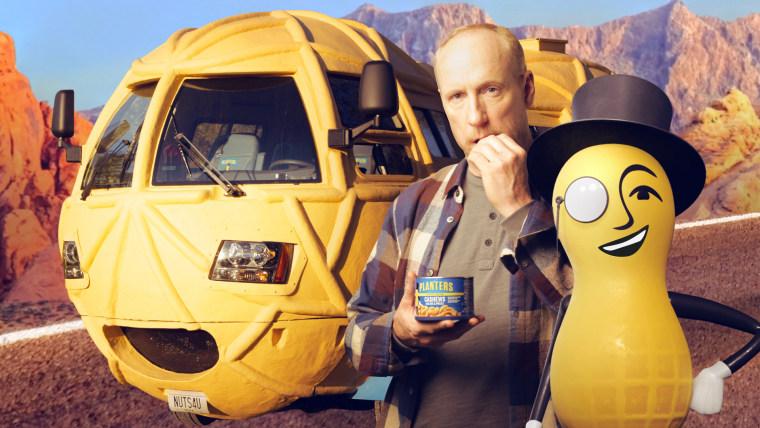Mr. Peanut is dead. Planters killed off the mascot in a playful pre-Super Bowl ad that portrays him as a life-saving hero. The company “leaked” the ad early, generating a ton of buzz in the media, particularly on Twitter, well in advance of the game.
The death of Kobe Bryant caused the company to pause some of its marketing on social media, according to The Washington Post, out of respect for the victims of the helicopter crash. But the ad — and Mr. Peanut’s death in an accident involving his “peanutmobile” — is going on as planned Sunday.
The death of Kobe Bryant caused the company to pause some of its marketing on social media. But Mr. Peanut’s death is going on as planned Sunday.
In this era of cord-cutting and skepticism of traditional marketing claims, advertisers are anxious to find ways to leverage online audiences, grab people’s attention and create a more intimate connection. Planters’ move is a sign of the latest stage in the “Brand Twitter” phenomenon, as marketers try to use the social media platform to involve consumers in a continuing story, like Budweiser’s trilogy following an adorable canine friendship.
Indeed, brands like Popeye’s have shown that establishing a unique voice in tweets, and even using their accounts to take some good-natured jabs at your competitors, can produce sensational results. But while some of these efforts work, others fall flat — and even become mired in controversy.
Planters has been getting great publicity off of this stunt. And by announcing that a Super Bowl ad will feature Mr. Peanut’s “funeral,” the team behind this campaign is building anticipation that will help Planters stay top-of-mind for consumers through the big game.
But this doesn’t mean the ad will ultimately succeed.
With price tags of up to $5.6 million for a 30-second spot this year, Super Bowl commercials are enormously expensive. Yet studies have found that most of them don’t actually lead to an increase in sales. Have the Super Bowl ads — and the many tweets about them every year — ever convinced you to switch your favorite brand of beer, toothpaste or car?
Across 25 years in the industry, I’ve seen what it takes for a campaign to affect consumer behavior and drive growth. It runs much deeper than Twitter; it happens in the subconscious.
Harvard Business School professor Gerald Zaltman has said 95 percent of purchase decision-making takes place in the subconscious mind. Last year, Wharton neuroscience professor Michael Platt and I published our research about the mental “shortcuts” that drive people’s choice of brands.
Inside our minds, we all have an intricate network of accumulated associations with any given brand.
Inside our minds, we all have an intricate network of accumulated associations with any given brand. I call this network of both positive and negative associations the “brand connectome.”
To win over new buyers, businesses need to grow their brand connectomes. The only way to do that is by adding positive associations about the brand itself. This is where most companies go wrong.
Often, even the most clever ads serve as little more than entertaining spectacles. For these ads to work, they can’t be gratuitous; they need to connect to the brand’s expertise and tell us meaningful things about the brand that we don’t know.
Thus far the Mr. Peanut campaign does not tell us whether Planters’ peanuts are of higher quality or tastier than their competitors, or whether they’re sustainably grown. In fact, Planters is taking a bit of risk by connecting a legacy brand in need of revitalization with death — not exactly a positive association in the subconscious.
Contrast that with one of the more successful Super Bowl ads I’ve seen in recent years, featuring Danny Devito as an M&M. Both the teaser (which the company included in a late January 2018 tweet) and the ad focused on how delicious and fun M&Ms are. The campaign was directly connected to the brand itself. AdAge reported that the company “seems to have gotten its money’s worth.” (The brand is owned by Mars, which is privately held. The company itself reported a 5.7 percent increase in revenue for 2018.)
The team behind the Mr. Peanut campaign has explained that it wanted to tap into how “the internet” responds to the death of a fictional character. Mike Pierantozzi, group creative director at Planters' agency VaynerMedia, said the ad was at least partially inspired by the high-profile deaths in Marvel’s “Avengers” franchise — and the reaction it triggered on Twitter. To me, Planters would have been more strategic for the long term by portraying Mr. Peanut as a superhero who risks his life not only to save other people’s lives, but also to save them from eating inferior peanuts.
Still, no brand ends the life of a mascot after more than 100 years lightly (Mr. Peanut was created in 1916). It’s quite possible that the company felt that this character, clad in a monocle and top hat and carrying a cane, did not resonate in this era and could not be revived. But I’ve found that it’s generally better to reinvent a distinctive brand asset than to walk away from it altogether.
Either way, simply getting a product into the conversation isn’t good enough. A campaign that drives buzz can and should also drive business. The key for Planters, as with other companies tweeting and advertising around the Super Bowl, is to use the sudden burst of attention in a way that’s not just entertaining but also productive. Will this “funeral” give people a new perspective on Planters that grows their brand connectome and changes their behavior?
Perhaps the story of Mr. Peanut’s demise will help breathe new life into the brand. Or this campaign could be looked back on as proof that going viral on Twitter isn’t all it’s cracked up to be.
Related:

